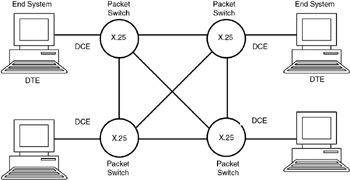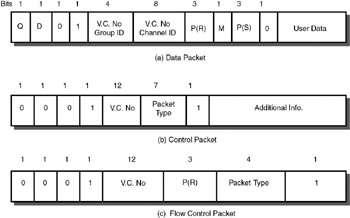18.2 OVERVIEW OF X.25
|
| < Day Day Up > |
|
18.2 OVERVIEW OF X.25
A typical X.25-based packet switched network is shown in Figure 18.1. The network consists of the end systems, called data terminal equipment (DTE), and the X.25 packet switches, called the data circuit terminating equipment (DCE). The packet switches are linked through communication media for transport of data in the form of packets. The packet size is variable, with a maximum limit of 1024 bytes.

Figure 18.1: X.25 packet switched network.
ITU-T Recommendation X.25 (also referred to as the X.25 standard) is the specification for interface between an end system and packet switch. Most of the public data networks (PDNs) and ISDN packet switching networks use the X.25 standard.
An X.25 network consists of packet switches and end systems. The data transmission is done in packet format, the maximum packet size being 1024 bytes.
| Note | X.25 protocols address the first three layers of the OSI reference model: physical layer, datalink layer, and network layer. |
X.25 covers the first three layers in the OSI reference model: physical layer, datalink layer, and network layer.
Physical layer: This layer specifies the physical interface between the end system (DTE) and the link to the switching node (DCE). RS232 can be used as the physical layer.
Datalink layer: This layer ensures reliable data transfer as a sequence of frames. Link access protocol balanced (LAPB), a subset of HDLC, is used at this layer.
| Note | The datalink layer in X.25 is called link access protocol balanced (LAPB). LAPB is derived from HDLC. |
Network layer: This is also called the packet layer. This layer provides the virtual circuit functionality. X.25 provides two types of virtual circuits:
-
Switched virtual circuit: A virtual circuit is established dynamically between two DTEs whenever required, using call setup and call clearing procedures.
-
Permanent virtual circuit: This is a fixed, network-assigned virtual circuit, and hence call setup and call clearing procedures are not required. This is equivalent to a leased line.
Protocol encapsulation in X.25 networks is shown in Figure 18.2. The data from a higher layer is passed on to the X.25 packet layer. The packet layer inserts control information as header and makes a packet. The packet is passed on to the datalink layer (LAPB), which adds the header and trailer and forms an LAPB frame. This frame is passed on to the physical layer for transmission over the medium.

Figure 18.2: Protocol encapsulation in X.25.
X.25 supports multiplexing. A DTE can establish 4095 virtual circuits simultaneously with other DTEs over a single DTE-DCE link. Each packet contains a 12-bit virtual circuit number.
X.25 supports virtual circuits. A virtual circuit is established between two end systems. The virtual circuit can be set up on a per-call basis or it can be permanent. These are called switched virtual circuit and permanent virtual circuit, respectively.
The procedure for establishing a call between the source DTE and the destination DTE in an X.25 network is as follows:
-
Source DTE sends a call-request packet to its DCE. The packet includes the source address, destination address, and virtual circuit number.
-
Network routes the packet to the destination's DCE.
-
Destination's DCE sends an incoming-call packet to the destination DTE. This packet has the same frame format as the call-request packet but different virtual circuit number selected by the destination's DCE.
-
Destination DTE sends a call-accepted packet.
-
Source's DCE receives call-accepted packet and sends call-connected packet to the source DTE. Virtual circuit number is same as that in the call-request packet.
-
Source DTE and destination DTE use their respective virtual circuit numbers to exchange data and control packets.
-
Source/destination sends a clear-request packet to terminate the virtual circuit and receives a clear-confirmation packet.
-
Source/destination receives a clear-indication packet and transmits a clear-confirmation packet.
In an X.25 network, communication takes place in three stages: (a) call setup; (b) data transfer; and (c) call disconnection. Hence, X.25 provides a connection-oriented service.
The protocol is to send a set of packets to establish a call, transfer data and control information, and call disconnection. For each type of packet, the packet format is specified. The various packets exchanged are:
| Call setup packets: | From DTE to DCE, call-request and call-accepted packets |
| Call clearing packets: | From DTE to DCE, clear-request and clear-confirmation packets |
| Data transfer packets: | Data packets |
| Interruption packets: | Interrupt and interrupt confirmation packets |
| Flow control packets: | RR (receiver ready) packet |
| Reset packets: | Reset request, reset confirmation packets |
| Restart packets: | From DTE to DCE, restart-request, restart-confirmation packets |
| Diagnostics packets: | Packets that carry diagnostics information |
| Registration packets: | Request-registration and request-confirmation packets |
For each type of packets, the packet formats are specified in the X.25 recommendations. Formats of some of the packets are discussed here.
| Note | The large number of packet exchanges indicates that the protocol overhead is very high in X.25 networks. However, this is an excellent protocol to use on transmission media that are characterized by high error rates. |
The different types of packets exchanged in an X.25 network are call setup packets, call clearing packets, interruption packets, reset packets, restart packets, flow control packets, registration packets, and data packets.
The various fields in a data packet are Q bit, virtual circuit number, send sequence number, receive sequence number, M bit, and user data.
The format of data packet is shown in Figure 18.3(a). The fields in the data packet are:
Q (1 bit): The Q bit is not defined in the standard—it can be used to define two types of data packets.
Virtual circuit number (12 bits): The 12 bits are divided into 4 bits for group ID and 8 bits for channel ID, which together form the virtual circuit number.
P(R) and P(S): Send sequence number and receive sequence number used for flow control as in HDLC.

Figure 18.3: X.25 Packet Formats.
D = 0 for acknowledgement between DTE and network (for flow control), and D = 1 for acknowledgement from remote DTE.
M bit: In X.25, two types of packets are defined—A packets and B packets. In A packets, M = 1 and D = 0, indicating that the packet is full; it is of maximum allowable packet length. B packet is a packet that is not an A packet. The packet sequence consists of a number of A packets and one B packet.
The format of a control packet is shown in Figure 18.3(b). This format is used for all packets for call setup and call disconnection. For example, the call-request packet will have additional information containing calling DTE address length (four bits), called DTE address length (four bits), calling DTE address, called DTE address.
The format of flow control packet is shown in Figure 18.3(c). P(R) indicates the number of the next packet expected to be received. Note that flow control is used at both layers 2 and 3 in X.25.
|
| < Day Day Up > |
|
EAN: 2147483647
Pages: 313